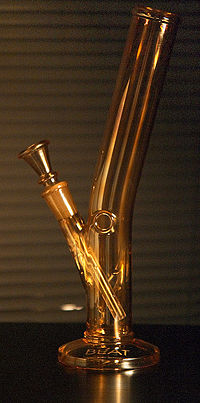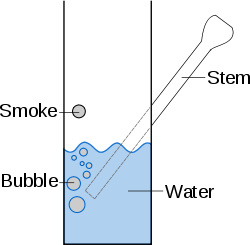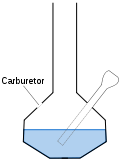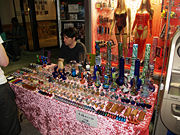Bong
- See also: Bong (disambiguation)

A bong, also commonly known as a water pipe, is a smoking device, generally used to smoke cannabis, tobacco, or other substances.[1][2] The construction of a bong and its principle of action is similar to that of the hookah, which is also called "water pipe."
A bong may be constructed from any air- and water-tight vessel by adding a bowl and stem apparatus (a slide)[3].
Contents |
Etymology
The word bong is an adaptation of the Thai word baung (Thai: บ้อง /bɔːŋ/),[4] a cylindrical wooden tube, pipe, or container cut from bamboo, and which also refers to the bong used for smoking. Bongs have been in use, primarily by the Hmong, in Laos and Thailand, for centuries. One of the earliest recorded uses of the word in Western literature dates to a piece in the January 1971 issue of the Marijuana Review.[5] An even earlier reference, the McFarland Thai-English Dictionary, published in 1944 describes one of the meanings of bong in the Thai language as, "a bamboo waterpipe for smoking kancha, tree, hashish, or the hemp-plant."
Operation

To use a bong, the base of the bong pipe is filled with water. The substance to be smoked is packed into the cone piece (also known as the "bowl" or "bowl-piece") and ignited. The user places his/her lips inside the mouthpiece, forming a seal, and inhales, causing the flame to be drawn toward the substance. An inhalation is known as a "hit", "pull", "rip" or "toke." As the user inhales, the flame is drawn towards the substance, igniting it, and the smoke which is produced travels through a hollow pipe that is attached to the bottom of the bowl. The pipe enters via an airtight stem into a vessel containing water (or whatever other liquid is used). The smoke rises through the water, which cools and filters particulates from the smoke, and then the smoke is trapped in the air chamber above the water. At the side or back of the bong, above the water level, there is usually a small air hole called a "carburetor", "carb", "choke", "shotgun", "shottie" or "rush hole". The user of the bong covers the carb with a finger until the material in the bowl has burnt away, then uncovers and pulls all the smoke from the bong into their lungs (called "clearing" the bong). Not all bongs use a carb, however. Many higher end models have a removable bowl piece also known as a "slide" which works the same as a carb. These are usually known as "pull-stem" or "slide" bongs. With this type of bong the user hits the bong until the material has burnt away, and then pulls the slide out of the bong while clearing it.

Comparison with other smoking methods


The rationale behind the use of a bong is the claim that the cooling effect of the water helps to reduce the chance of burning the mouth, airways, and lungs. The water can trap some heavier particles and water-soluble molecules, preventing them from entering the smoker's airways.[6] Thus the mechanics or a bong function similarly to a laboratory gas washing bottle. This "filtration" can lead to the belief that bongs are less damaging than other smoking methods. However, a 2000 NORML-MAPS study found that "water pipes filter out more psychoactive THC than they do other tars, thereby requiring users to smoke more to reach their desired effect".[7] In the study, smoke from cannabis supplied by the NIDA was drawn through a number of smoking devices and analyzed. An inhalation machine, adjusted to mimic the puff length of cannabis smokers, drew smoke through a standard bong, a small portable bong with a folding stem, a bong with a motorized paddle that thoroughly mixes the smoke with the water, and two different types of vaporizers. Comparisons to traditional non-filtered smoking methods were not included in these experiment.
MAPS[8] also reviewed a study that examined the effects and composition of water-filtered and non-filtered cannabis and tobacco smoke. It found that when alveolar macrophages were exposed to unfiltered smoke, their ability to fight bacteria was reduced, unlike exposure to water-filtered smoke. It also found substantial epidemiological evidence of a lower incidence of carcinoma among tobacco smokers who used water-pipes, as opposed to cigarettes, cigars, and regular pipes. "It appears that water filtration can be effective in removing components from cannabis smoke that are known toxicants... The effectiveness of toxicant removal is related to the smoke's water contact area. Specially designed water pipes, incorporating particulate filters and gas-dispersion frits, would likely be most effective in this regard; the gas-dispersion frit serves to break up the smoke into very fine bubbles, thereby increasing its water-contact area."[9] This study suggests that a bong's smoke is less harmful than unfiltered smoke.
See also
- Operation Pipe Dreams
References
- ↑ "Office of National Drug Control Policy".
- ↑ "Contraband: The Sale of Regulated Goods on the Internet".
- ↑ Can a human skull be used as a bong?, retrieved 12 May 2008
- ↑ "Thai dictionary entry for baawng".
- ↑ The text read: Many thanks to Scott Bennett for the beautiful special bong he made for my pipe collection. Text cited in bong, n.3 The Oxford English Dictionary. 2nd ed. 1989. OED Online. Oxford University Press. 20 April 2006 http://dictionary.oed.com/cgi/entry/50024920
- ↑ "Marijuana Consumption: Smoking, Eating, And Drinking Marijuana".
- ↑ "MAPS/CaNORML vaporizer and waterpipe studies".
- ↑ Nicholas V. Cozzi, Ph.D. Effects of water filtration on marijuana smoke: a literature review
- ↑ Nicholas V. Cozzi, Ph.D. Effects of water filtration on marijuana smoke: a literature review
External links
|
||||||||||||||||||||